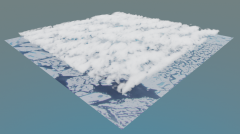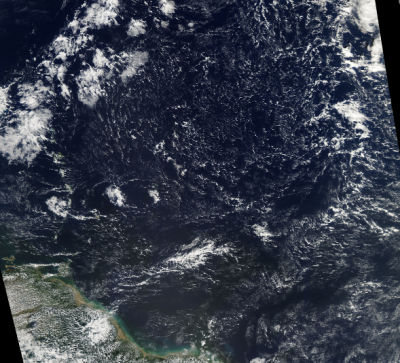Table of Contents
Student projects
A year in LES (AYIL): Large eddy simulation of the complete MOSAiC drift
From September 2019 to October 2020 the Polarstern Research Vessel drifted with the sea ice through the central Arctic, as part of the MOSAiC field campaign. Based on the observational data collected on the ship and by the instrumentation on the sea ice (MetCity), we performed daily Large-Eddy Simulations (LES) of the atmospheric domain surrounding the ship. The spatial and temporal resolutions were high enough to resolve small scale turbulence and clouds. The computational burden of this effort has been considerable, and performing these kind of simulations for a full year in the central Arctic has never been achieved before. With the production runs now completed, the model output can be evaluated against independent measurements. In addition, the simulated turbulence and clouds can be used to gain deeper insight into the ongoing rapid warming of the Arctic. This process is often referred to as Arctic Amplification, which is the central focus of the ongoing AC3 project. If you are interested in working with these data, for example to evaluate the LES against measurements or to use the high resolution model output as a virtual laboratory, please contact Roel Neggers
Modeling convective cloud population dynamics and organization as observed during EUREC4A
The spatial organization of moist atmospheric convection has been studied intensively in recent years. This effort is motivated by the recent insight that such organization plays an important role in feedbacks between clouds and Earth's climate. In addition, the spatial structure of convective fields should be taken into account when preparing global circulation models for the “grey zone” of resolutions at which convection becomes partially resolved. What exactly causes the observed spatial patterns in convective cloud fields, and how to represent those in weather and climate models, is not yet fully understood. At InScAPE we recently developed a conceptual model for populations of convective objects that live on a two-dimensional grid. This model, which is named BiOMi (Binomials on Microgrids), uses a Bernoulli process to represent object births, movement and life-cycles. This significantly enhances the computational efficiency. In addition, rules of interaction are prescribed that allow objects to cluster and form long-lived convective structures. These rules reflect known physics of cumulus clouds, introduce convective memory in the system, and make convective structures act like cellular automata. The work in this project includes the following activities.
- Perform experiments with the BiOMi population model for conditions observed during the EUREC4A campaign
- Compare the results with cloud patterns derived from high-resolution LES results and MODIS satellite images (see image below)
If you are interested in this topic please contact Roel Neggers.
The spatial organization of convective thermals during transitions from shallow to deep convection over land
Due to the continuing increase in resolution of atmospheric circulation models, convective processes that used to be fully parameterized are gradually becoming partially resolved, a situation referred to as the convective “grey zone”. This necessitates the development of parameterizations that are scale-aware and scale-adaptive, an area of intense current research. A recently pursued way of achieving this goal is to formulate population-dynamical models that adopt the convective thermal as the smallest unit or building block of convection. To help develop and improve such next-generation convective parameterizations, in this project we analyze large-eddy simulations of diurnal cycles of shallow-to-deep convective transitions observed at the ARM Southern Great Planes site. Based on previous algorithms from the literature, a tracking algorithm has been developed to gain insight into the behavior of populations of such thermals. Thermal characteristics including life-time, trajectory and geometric information, and kinematic and thermodynamic properties are investigated. Of particular interest is the spatial distribution of thermals, to gain insight into what drives their clustering and organization. Various metrics expressing the degree and type of spatial organization among thermals are explored to this purpose.
If you are interested in this topic please contact Roel Neggers.




